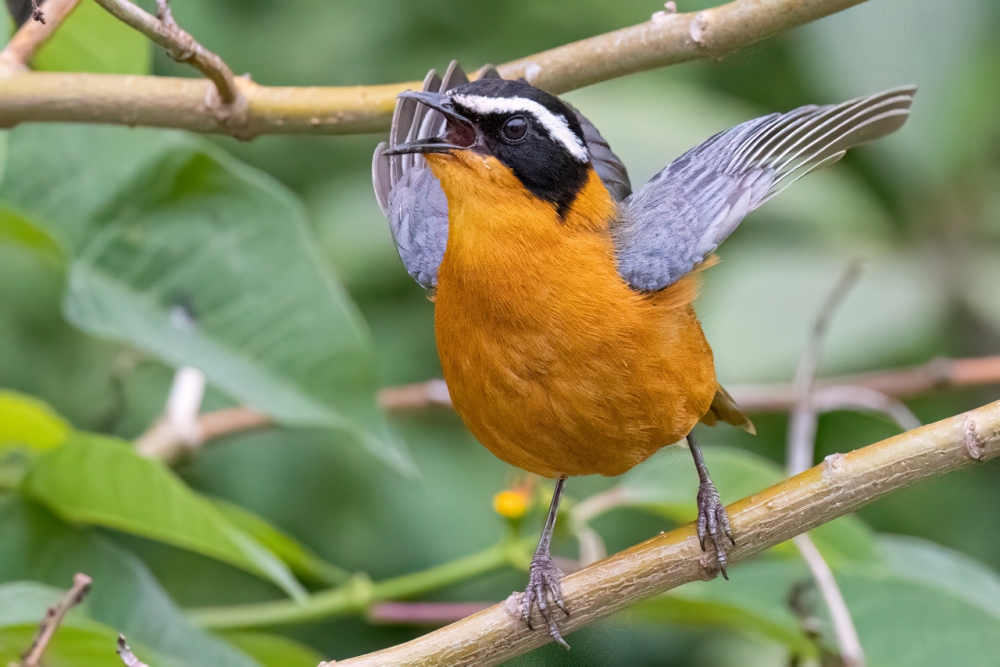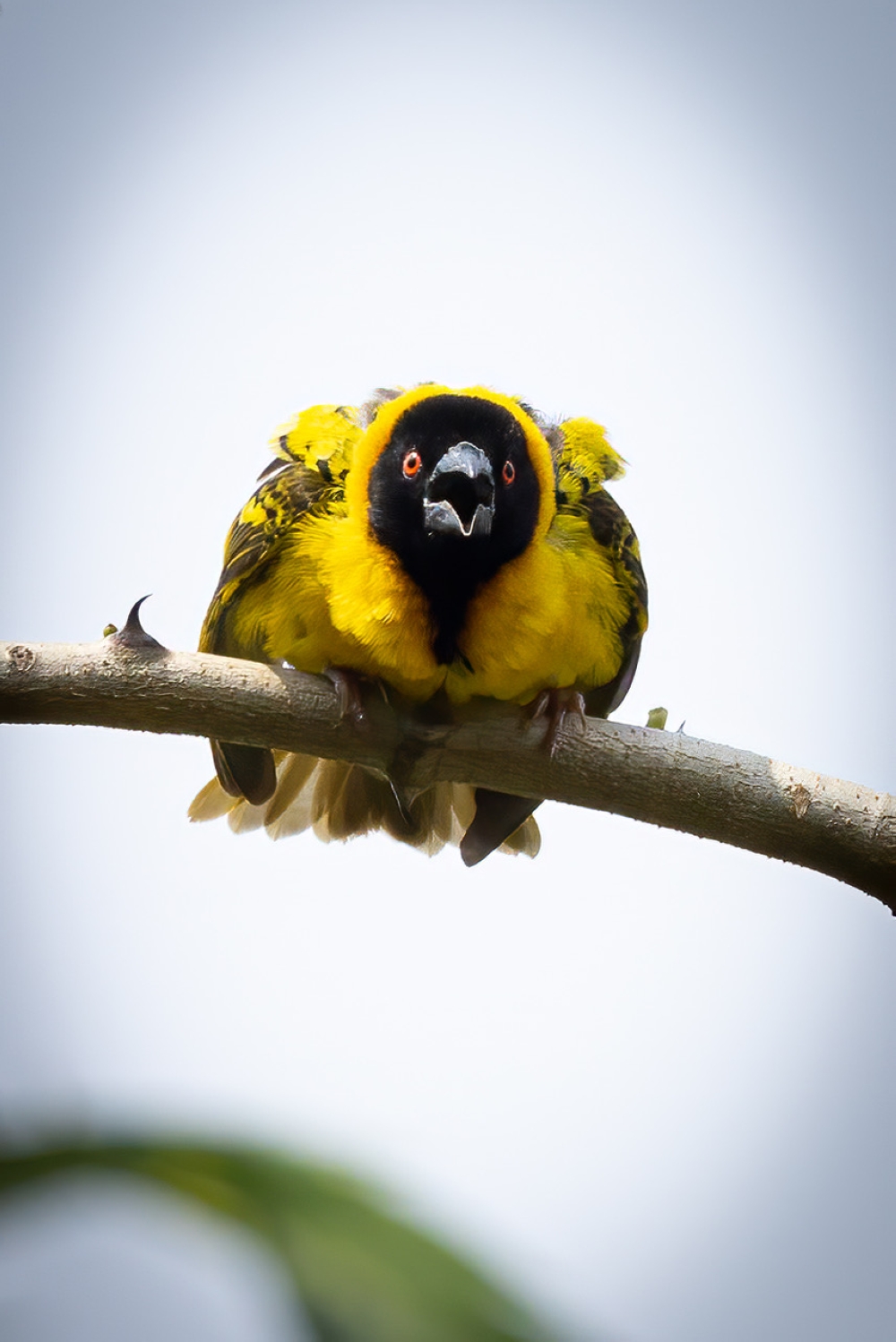

The songs and calls of Rwanda’s birds can be heard throughout the day – starting each day well before the sun rises and lasting until the sun sets in the evening. All birds vocalise, ranging from the shortest and simplest of calls through to the most complex and intricate of songs.
Few animals use their voices as eloquently as birds, other than us humans. We use the larynx (the lump in our throat known as the Adam’s apple) to create sound and whilst birds have a larynx their sound comes from the syrinx, a structure found deeper in the throat. This structure is divided into two independent units which allows the bird to create two sounds at the same time and the beautiful bird songs we hear.
The first calls of the day begin as the night sky starts to turn pale, just before the sun rises. These first calls prompt a cacophony of responses, initially from birds of the same species but with other species following shortly – welcome to the dawn chorus. The White-browed Robin-chat is the first bird I hear each morning in Kigali, quickly followed by the African Thrush and Northern Grey-headed Sparrow.
There are several possible reasons as to why this phenomenon occurs each morning with such intensity and concentration of species. The fact that the morning benefits from cooler temperatures, calmer air and less noise from insects and traffic therefore allowing a bird’s song to travel further, could be one reason that many choose that time of day to sing. Research has shown that birds living near airports sing their dawn chorus early enough to reduce overlapping with the roar of airplanes.


Another possible reason is the requirement for a bird to advertise their presence after a night on its own – mates, families and other groups which roost separately during the night need to locate each other at the start of each day. Sociable species that forage in flocks might use the dawn chorus as a way to synchronise their behaviour for the day – so they leave a roost together each morning.
It could also simply be that after a good night’s rest the birds are full of energy and want to let everyone know they survived the night - Mwaramutse! Birdsong can also improve our mood, a recent study published in Scientific Reports suggests that listening to birdsong can reduce our anxiety and paranoia, with effects lasting up to eight hours. Yet another reason why we should all go outside and listen to the chorus!
What is for sure – birds know where and when to sing! In the open, sound travels best a few feet above vegetation, so birds like to sing from elevated perches to reduce interference. An elevated perch also enables a bird to see further across their territory.
Many species do this in Rwanda, from the Rufous-naped Larks on the plains of Akagera National Park and the Waller’s Starling in Nyungwe National Park through to the Winding Cisticolas and Chinspot Batis found on the outskirts across Kigali. Those singing in the undergrowth or from the forest floor use lower frequencies than those singing in the trees.
Science is only scratching the surface of bird vocalisations and their complex meanings – a task only made harder by the realisation that some species make sound in the ultrasound range, which is beyond our human hearing! Add to this the fact there is also regional variation in the vocalisations of some species, in other words some birds have dialects like our human accents!
Birds use vocalisations to attract a mate, locate a mate or member of their group, advertise territory or their presence in the area, as well as advertise threats or predators to others.
Whereas their calls are typically short and succinct (like a human scream or laugh), used to make a point, songs are usually longer and more complex. Great examples of bird calls heard here in Rwanda include the Hadada Ibis, Hamerkop and Yellow-billed Kite.
Many people assume that birdsongs are genetically encoded – birds are born already knowing them, but this is not the case. Songbirds go through the same process of vocal learning as we do!
Like us when we first learn to speak, they first listen to adult teachers and then they imitate, experiment and practice to hone their skills. Across Rwanda you can hear the most beautiful and melodic bird songs, examples include the various Larks, African Pied Wagtail, Klaas’s Cuckoo and Papyrus Gonolek.
Some species take their individual songs a step further and sing together, either as a duet or as a group. The Black-headed Gonolek, Tropical Boubou and African Fish Eagle are just three of many species found here in Rwanda that will sing together as a pair.
Sometimes the pair will sing alternate notes in the same song whereas other times they will simply sing the same notes at the same time. Often the song is synchronised so well to a human listener it sounds like a single song. Duetting can help maintain the couple’s pair bond as well as assist with securing the couple’s territory – any potential intruder hearing a well synchronised duet will know they’re up against a strong team and stay away. The benefits of duetting can be amplified further if a group sings together; the synchronisation is lost to raucous calls by the whole group... Great examples include the Grey-backed Fiscal found in wetlands around Kigali, the White-headed Woodhoopoes and Turacos in Nyungwe National Park and the Bare-faced Go Away Birds seen and heard in Akagera National Park.
Some species take their learning even further and rather than just learning their own songs will also learn the songs of other species and even the sounds of other animals and humans. Here in Rwanda notable mimics include the Grey Parrot found in Nyungwe National Park and the Blue-shouldered Robin-chat found in Akagera National Park.
Whilst some species weave these sounds and songs into their own songs to show off to potential mates, others use them to trick other birds and animals to get some free food! From an elevated perch, the Fork-tailed Drongo will watch other birds hunting and when they have found food it will mimic their alarm call, hearing the alarm call other birds fly away leaving the drongo to swoop in and collect the food.
The more I learn about birds and their behaviour, the more I realise I have hardly scratched the surface of what they have to offer.
--
Bibliography
Stobbe, E. (2022) Birdsongs alleviate anxiety and paranoia in healthy participants, Scientific Reports, 12: 16414. [Online] Available at: https://www.nature.com/articles/s41598-022-20841-0


